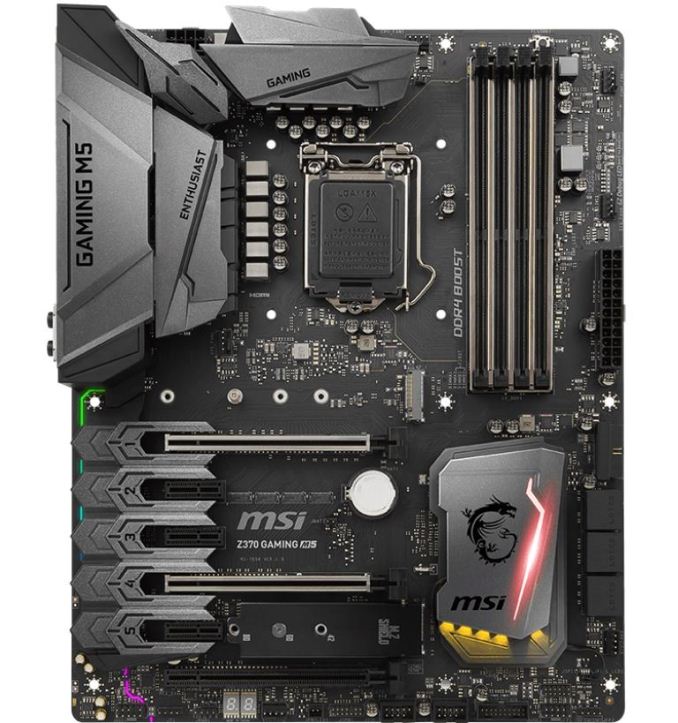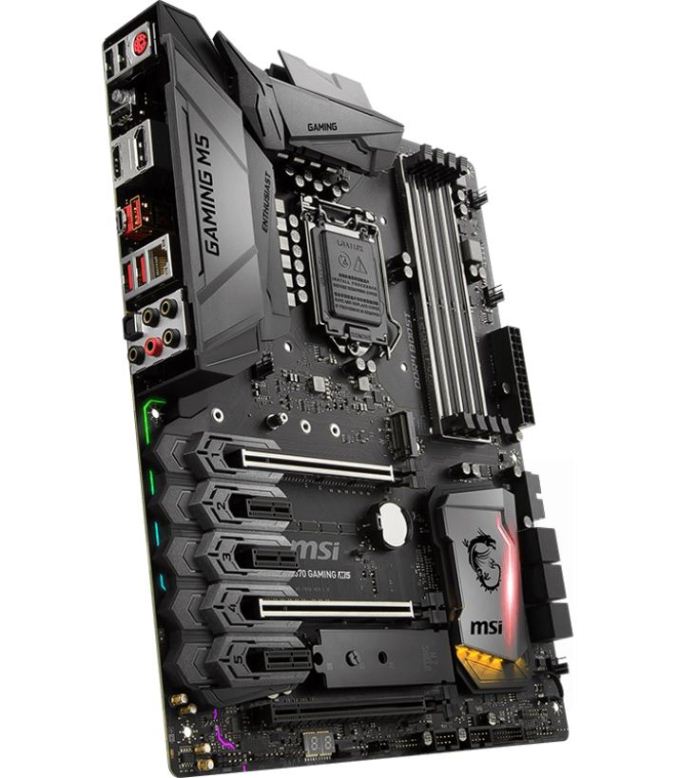Analyzing Z370 for Intel's 8th Generation Coffee Lake: A Quick Look at 50+ Motherboards
by Ian Cutress, Anton Shilov, Joe Shields & Gavin Bonshor on October 20, 2017 2:00 PM ESTMSI Z370 Gaming M5
Another board currently in MSI’s Enthusiast Gaming lineup is the Z370 Gaming M5. Outside of size, the Gaming M5 is ATX versus the Godlike at E-ATX.
The overall theme on the board is a black PCB with a few grey highlights of components mixed in. The top half of the board should look pretty familiar when comparing the Gaming M5 to the Godlike Gaming flagship. While the shape of the shroud and VRM heatsinks are the same, the RGB LEDs inside on the Godlike were removed. It still carries over the fortified memory slots but loses some fan header connectivity as well as losing other RGB LEDs in that area. The PCIe area has a shroud between the slots and covers the audio portion of the board but it is not an extension of the back panel IO shroud. The PCH heatsink loses the GPU stand but keeps the same shape and RGB LEDs. Additional RGB strip support can be found through the RGB connector on the bottom of the board.
The four memory slots supports up to 64 GB in dual channel mode, with a supported speed up to DDR4-4000. There are a total of three full-length PCIe slots, the first two from the CPU using reinforced slots while the third is from the chipset. This allows for running in x16/x0/x4 or x8/x8/x4 configurations, and supports 3-way AMD Crossfire and 2-way NVIDIA SLI. Between the full-length slots are three x1 slots, getting their bandwidth from the chipset.
The board has the usual complement of six SATA ports all located on the right side of the board next to the chipset heatsink. As a side note, SATA 1/5 will be unavailable when an M.2 SATA SSD module has been installed in the first M.2 slot, while SATA 5/6 will be unavailable when an M.2 SATA SSD is used in the second M.2 slot. RAID 0, 1, 5, and 10 are supported for all SATA devices. A total of six 4-pin fan headers are found in various locations throughout the board: four system fans, one water pump, and one CPU fan connector. The audio is handled by the latest Realtek ALC1220 codec along with Chemicon audio caps and the familiar audio separation line running splitting the audio section from the rest of the board, minimizing interference. A single Rivet Networks Killer E2500 gigabit Ethernet controller is found on the Gaming M5. The power, reset, and Game Boost knob are gone, however, a debug LED can still be found on the bottom of the board.
USB 3.1 (10 Gbps) is handled by the ASMedia 3142 controller and gives the board a Type-C and a Type-A port on the back panel IO. The chipset handles six USB 3.1 (5 Gbps) ports with two Type-A on the back panel and four more through internal USB connectors. There are three USB 2.0 ports on the back panel also, and four more through internal USB headers. The back panel also has a combination PS/2 connector, a CMOS reset button, DisplayPort and HDMI video outputs, the E2500 network port, and the audio stack with SPDIF.













83 Comments
View All Comments
tommythorn - Monday, October 23, 2017 - link
While that feature page is great, the thunderbolt part is slightly misleading as a few of them supports it via an add-in-card. The page only lists the one that has it built-in. (The lackluster support for TB3 as well as 10 GbE is disappointing).OFelix - Saturday, October 21, 2017 - link
ThanksStochastic - Friday, October 20, 2017 - link
Would you consider putting out some simple Wirecutter-style recommendations? A lot of people (including myself) would like someone else who is better informed to simplify the decision-making process.Ian Cutress - Friday, October 20, 2017 - link
When we get our Z370 reviews underway, we'll start doing some buyers guidesStochastic - Friday, October 20, 2017 - link
Great, thanks!IGTrading - Sunday, October 22, 2017 - link
When do we get a 50+ AMD motherboard article guys ? :)abrowne1993 - Friday, October 20, 2017 - link
Okay but which one looks the coolest?dave_the_nerd - Friday, October 20, 2017 - link
"Whoever thought this was a good idea at Intel needs to be fired."Well... gee... why don't you tell us how you really feel?
DigitalFreak - Friday, October 20, 2017 - link
This whole notch thing makes me wonder if the 8xxx series was originally supposed to work in existing motherboards, but Intel ran into issues at the last minute.KaarlisK - Saturday, October 21, 2017 - link
Honestly, I cannot see the issue. The pins were changed so that nothing bad will happen if you put the wrong CPU in the wrong motherboard.As for the notches, I for one am happy that they were not changed. This means they can reuse the physical design, which lowers validation costs, which makes the CPUs cheaper.